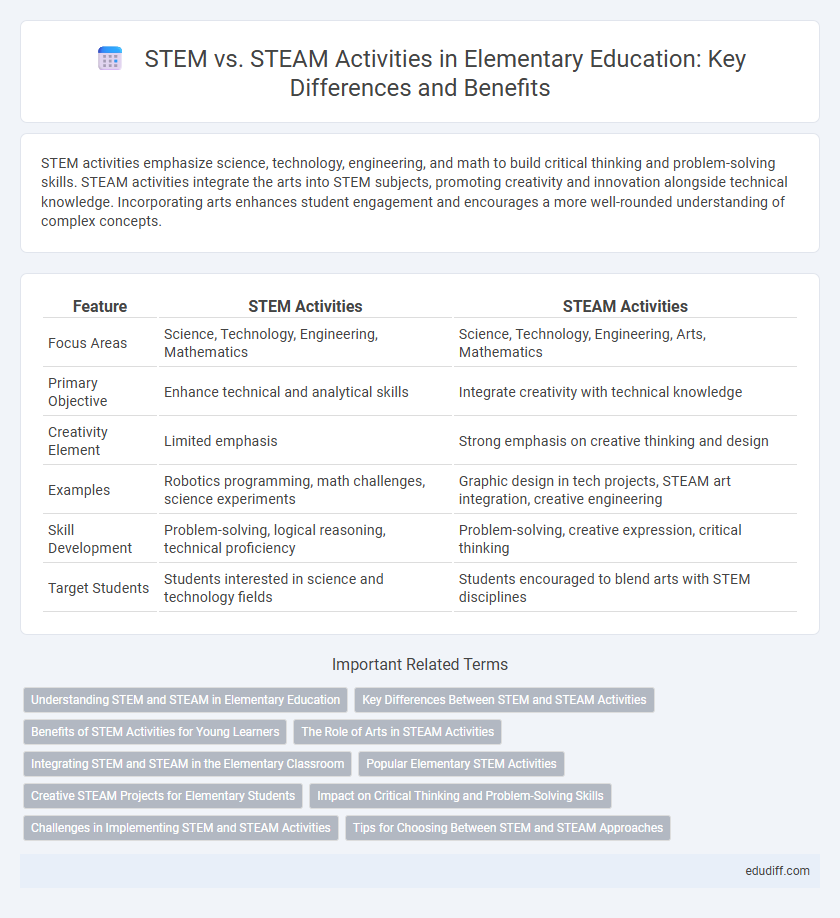STEM activities emphasize science, technology, engineering, and math to build critical thinking and problem-solving skills. STEAM activities integrate the arts into STEM subjects, promoting creativity and innovation alongside technical knowledge. Incorporating arts enhances student engagement and encourages a more well-rounded understanding of complex concepts.
Table of Comparison
| Feature | STEM Activities | STEAM Activities |
|---|---|---|
| Focus Areas | Science, Technology, Engineering, Mathematics | Science, Technology, Engineering, Arts, Mathematics |
| Primary Objective | Enhance technical and analytical skills | Integrate creativity with technical knowledge |
| Creativity Element | Limited emphasis | Strong emphasis on creative thinking and design |
| Examples | Robotics programming, math challenges, science experiments | Graphic design in tech projects, STEAM art integration, creative engineering |
| Skill Development | Problem-solving, logical reasoning, technical proficiency | Problem-solving, creative expression, critical thinking |
| Target Students | Students interested in science and technology fields | Students encouraged to blend arts with STEM disciplines |
Understanding STEM and STEAM in Elementary Education
STEM activities in elementary education emphasize Science, Technology, Engineering, and Mathematics to develop critical thinking and problem-solving skills through hands-on experiments and projects. STEAM adds Art to the STEM framework, encouraging creativity and innovation by integrating design, visual arts, and creative expression into technical learning. Understanding the difference helps educators foster a balanced approach that nurtures both analytical and creative abilities in young learners.
Key Differences Between STEM and STEAM Activities
STEM activities emphasize Science, Technology, Engineering, and Math while STEAM integrates Art to foster creativity alongside technical skills. The inclusion of Art in STEAM encourages design thinking and innovation, enriching problem-solving approaches. Key differences lie in STEAM's focus on creativity and expression, contrasting with STEM's concentration on analytical and technical development.
Benefits of STEM Activities for Young Learners
STEM activities for young learners enhance critical thinking, problem-solving skills, and creativity by engaging them in science, technology, engineering, and math concepts through hands-on experiments and projects. These activities foster early interest in technical subjects, helping to build a strong foundation for future academic success in STEM fields. Developing collaboration and communication skills is another benefit, as students often work in teams to complete challenges and solve real-world problems.
The Role of Arts in STEAM Activities
STEAM activities integrate the arts with science, technology, engineering, and math to enhance creativity and innovation in elementary education. Incorporating arts in STEAM encourages students to think critically, approach problems from multiple perspectives, and develop communication skills through design and storytelling. This holistic approach fosters deeper engagement and helps students apply technical concepts in imaginative and meaningful ways.
Integrating STEM and STEAM in the Elementary Classroom
Integrating STEM and STEAM activities in the elementary classroom enhances critical thinking and creativity by combining science, technology, engineering, math, and the arts. STEM focuses on problem-solving skills through hands-on experiments and coding projects, while STEAM incorporates art to foster innovation and expression. Using cross-disciplinary projects like building models or designing artistic experiments supports holistic learning and student engagement.
Popular Elementary STEM Activities
Popular elementary STEM activities, such as building simple circuits, coding basic robots, and conducting hands-on science experiments, foster critical thinking and problem-solving skills. These activities emphasize science, technology, engineering, and math, promoting a strong foundation in analytical skills and innovation. Incorporating hands-on challenges and collaborative projects enhances engagement and prepares students for future STEM learning.
Creative STEAM Projects for Elementary Students
Creative STEAM projects for elementary students integrate science, technology, engineering, art, and math to foster critical thinking and innovation. Incorporating art into STEM activities enhances creativity and engagement, allowing young learners to explore complex concepts through hands-on, imaginative tasks. These projects develop problem-solving skills while encouraging self-expression and collaboration in early education.
Impact on Critical Thinking and Problem-Solving Skills
STEM activities emphasize science, technology, engineering, and math, fostering analytical thinking and structured problem-solving skills essential for early cognitive development. STEAM adds the arts, encouraging creativity and innovation, which enhances critical thinking by integrating diverse perspectives and promoting flexible problem-solving strategies. Incorporating the arts in STEM education supports a more holistic approach, improving students' ability to tackle complex problems with both logical reasoning and creative insight.
Challenges in Implementing STEM and STEAM Activities
Implementing STEM and STEAM activities in elementary education faces challenges such as limited resources, insufficient teacher training, and balancing curriculum time with hands-on experimentation. Integrating arts into STEM to form STEAM requires additional materials and creative instructional methods, which can strain school budgets and complicate lesson planning. Overcoming these hurdles demands targeted professional development and adequate funding to support effective, interdisciplinary learning experiences.
Tips for Choosing Between STEM and STEAM Approaches
Choosing between STEM and STEAM approaches depends on the educational goals and student interests, with STEM focusing on science, technology, engineering, and math, while STEAM integrates the arts to promote creativity. Consider the importance of fostering critical thinking and problem-solving skills through hands-on experiments, balanced with opportunities for creative expression and innovation. Assess available resources, teacher expertise, and curriculum alignment to ensure effective implementation tailored to elementary students' developmental needs.
STEM Activities vs STEAM Activities Infographic

 edudiff.com
edudiff.com